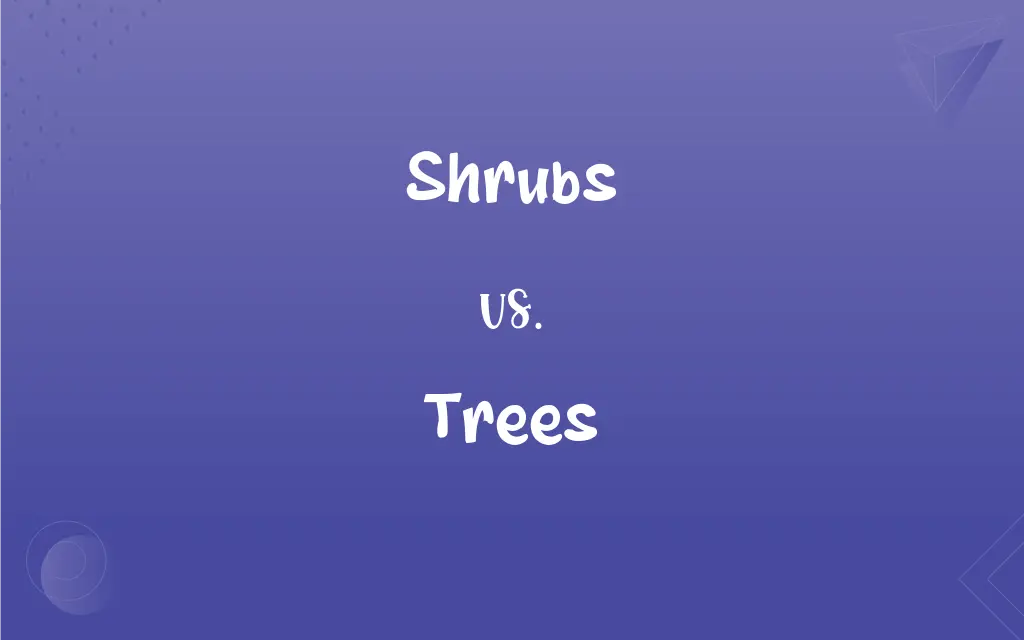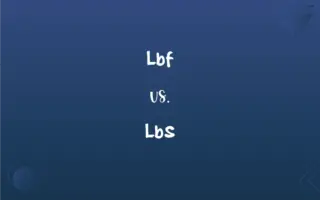Shrubs vs. Trees: What's the Difference?
Edited by Aimie Carlson || By Harlon Moss || Published on April 15, 2024
Shrubs are small to medium-sized woody plants with multiple stems, while trees are large, single-stemmed plants with a distinct trunk.

Key Differences
Shrubs are characterized by their multiple stems and shorter height, typically under 6 meters (20 feet), which allows them to occupy the understorey of forests or form thickets in open areas. Trees, on the other hand, grow taller than shrubs, usually exceeding 6 meters in height, with a single main stem or trunk that supports a distinct crown of foliage. This difference in structure reflects their roles in various ecosystems, with shrubs often providing understorey habitat and food for wildlife, while trees form the overstorey, offering shade and habitat for different species.
Shrubs tend to have a bushy appearance due to their multiple stems that grow from the base, making them dense and often used for privacy hedges or decorative landscaping. Trees usually have a clear trunk for some height above the ground before branching out, making them prominent landscape features used for shade, windbreaks, and aesthetic purposes. The growth habit of shrubs and trees affects their use in landscaping and their ecological roles, with shrubs filling spaces between the ground and taller trees, and trees providing a canopy for understorey plants and animals.
The life span of shrubs and trees can also differ significantly, with many shrubs living for a few decades while trees can live for hundreds or even thousands of years. This longevity of trees contributes to their role in carbon sequestration and as long-standing components of their ecosystems. Shrubs, with their shorter life spans, often colonize disturbed or transitional areas quickly, playing a crucial role in ecosystem succession and recovery.
Shrubs typically require less space to grow than trees, making them suitable for smaller gardens and landscapes where they can provide color, texture, and structure without the space requirements of large trees. Trees, because of their size and longevity, are often considered investments in a landscape, requiring more space to grow but providing significant benefits in terms of shade, air purification, and habitat over a longer period.
Shrubs and trees differ in their reproductive strategies as well, with some shrubs able to propagate easily from cuttings or sprouting from the base after being cut down, allowing them to spread or recover from damage more readily. Trees may rely on seed dispersal for propagation, with their seeds often adapted to travel far from the parent plant, aiding in the spread of the species across larger areas. This distinction highlights the adaptability of shrubs in various environments and the role of trees in forest expansion and diversity.
ADVERTISEMENT
Comparison Chart
Height
Usually under 6 meters (20 feet)
Typically over 6 meters (20 feet)
Stem Structure
Multiple stems from the base
Single main stem or trunk
Life Span
Shorter, often a few decades
Longer, can live for hundreds of years
Space Requirement
Less, suitable for smaller areas
More, due to larger size
Role in Ecosystem
Understorey habitat, quick recovery
Canopy layer, long-term habitat
ADVERTISEMENT
Shrubs and Trees Definitions
Shrubs
Shrubs are characterized by their bushy appearance.
Shrubs like hydrangeas added color to the landscape.
Trees
Trees are large plants with a single main stem or trunk.
The oak tree in our backyard provides ample shade in the summer.
Shrubs
Shrubs are small to medium-sized woody plants with multiple stems.
The garden was bordered by a variety of flowering shrubs.
Trees
Trees can live for hundreds to thousands of years.
Ancient trees in the forest stood as silent witnesses to history.
Shrubs
Shrubs are often used in landscaping for hedges and borders.
We planted shrubs along the walkway for a natural look.
Trees
Trees play a crucial role in the carbon cycle by sequestering carbon dioxide.
Planting trees is a natural way to combat climate change.
Shrubs
Shrubs serve as important understorey plants in ecosystems.
Native shrubs provide habitat for numerous bird species.
Trees
Trees are key components of both urban and rural landscapes.
City parks are often filled with trees to offer residents a respite from concrete.
Shrubs
Shrubs can be deciduous or evergreen.
The evergreen shrubs retained their leaves all winter.
Trees
A perennial woody plant having a main trunk and usually a distinct crown.
Shrubs
A woody plant of relatively low height, having several stems arising from the base and lacking a single trunk; a bush.
Trees
An herbaceous plant or shrub resembling a tree in form or size.
Shrubs
A beverage made from fruit juice, sugar, and a liquor such as rum or brandy.
Trees
Something that resembles a tree in form, especially a diagram or arrangement that has branches showing relationships of hierarchy or lineage.
Shrubs
Plural of shrub
Trees
(Computers) A structure for organizing or classifying data in which every item can be traced to a single origin through a unique path.
Trees
A wooden beam, post, stake, or bar used as part of a framework or structure.
Trees
A saddletree.
Trees
A gallows.
Trees
The cross on which Jesus was crucified.
Trees
To force up a tree
Dogs treed the raccoon.
Trees
(Informal) To force into a difficult position; corner
The reporters finally treed the mayor.
Trees
To supply or cover with trees
A hillside that is treed with oaks.
Trees
Plural of tree
Trees
Trees provide habitat and food for wildlife.
Birds nest in the tall trees, finding food and shelter in their branches.
FAQs
What defines a tree?
A tree is a large, perennial woody plant with a single main stem or trunk.
How do the lifespans of shrubs and trees compare?
Trees generally have longer lifespans than shrubs, living for hundreds to thousands of years.
How do shrubs and trees benefit the environment?
Both play crucial roles in carbon sequestration, habitat provision, and soil stabilization.
How do shrubs and trees differ in height?
Shrubs are typically under 6 meters tall, while trees are usually over 6 meters tall.
Do trees always have a single trunk?
Most trees have a single trunk, but some species can develop multiple trunks.
Are shrubs important for wildlife?
Yes, shrubs provide essential habitat and food for various wildlife species.
Can trees be used as hedges?
While trees can form natural barriers, shrubs are more commonly used as hedges due to their size and density.
Can shrubs be planted under trees?
Yes, shrubs can be planted under trees, taking advantage of the shade and moisture provided.
What defines a shrub?
A shrub is a small to medium-sized perennial woody plant with multiple stems.
Can shrubs become trees?
Some shrubs can grow into tree-like forms under certain conditions but generally retain characteristics that classify them as shrubs.
Are all shrubs evergreen?
No, shrubs can be either evergreen or deciduous.
Are there shrubs that look like trees?
Yes, some shrubs, especially when mature, can resemble trees in appearance.
How are shrubs used in landscaping?
Shrubs are used for borders, hedges, and decorative purposes due to their varied sizes and shapes.
Do trees need more space than shrubs?
Yes, due to their larger size, trees require more space to grow than shrubs.
Can shrubs be used for privacy?
Yes, densely planted shrubs are often used as privacy screens in gardens and landscapes.
How do trees affect property value?
Trees can significantly increase property value by enhancing landscape aesthetics and providing environmental benefits.
Are there any invasive species of shrubs or trees?
Yes, there are invasive shrub and tree species that can disrupt local ecosystems and require management.
What role do trees play in urban areas?
Trees provide shade, improve air quality, and enhance the aesthetic appeal of urban areas.
How do deciduous and evergreen trees differ?
Deciduous trees lose their leaves seasonally, while evergreen trees retain theirs throughout the year.
What maintenance does a shrub require?
Shrubs may require pruning, watering, and fertilizing to maintain health and shape.
About Author
Written by
Harlon MossHarlon is a seasoned quality moderator and accomplished content writer for Difference Wiki. An alumnus of the prestigious University of California, he earned his degree in Computer Science. Leveraging his academic background, Harlon brings a meticulous and informed perspective to his work, ensuring content accuracy and excellence.
Edited by
Aimie CarlsonAimie Carlson, holding a master's degree in English literature, is a fervent English language enthusiast. She lends her writing talents to Difference Wiki, a prominent website that specializes in comparisons, offering readers insightful analyses that both captivate and inform.































































